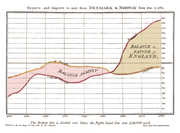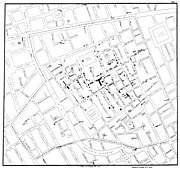

| Part of a series on Statistics |
| Data and information visualization |
|---|
| Major dimensions |
| Important figures |
| Information graphic types |
| Related topics |
|
|
Statistical graphics, also known as statistical graphical techniques, are graphics used in the field of statistics for data visualization.
Whereas statistics and data analysis procedures generally yield their output in numeric or tabular form, graphical techniques allow such results to be displayed in some sort of pictorial form. They include plots such as scatter plots, histograms, probability plots, spaghetti plots, residual plots, box plots, block plots and biplots.[1]
Exploratory data analysis (EDA) relies heavily on such techniques. They can also provide insight into a data set to help with testing assumptions, model selection and regression model validation, estimator selection, relationship identification, factor effect determination, and outlier detection. In addition, the choice of appropriate statistical graphics can provide a convincing means of communicating the underlying message that is present in the data to others.[1]
Graphical statistical methods have four objectives:[2]
If one is not using statistical graphics, then one is forfeiting insight into one or more aspects of the underlying structure of the data.
Statistical graphics have been central to the development of science and date to the earliest attempts to analyse data. Many familiar forms, including bivariate plots, statistical maps, bar charts, and coordinate paper were used in the 18th century. Statistical graphics developed through attention to four problems:[3]
Since the 1970s statistical graphics have been re-emerging as an important analytic tool with the revitalisation of computer graphics and related technologies.[3]


Famous graphics were designed by:
See the plots page for many more examples of statistical graphics.
![]() This article incorporates public domain material from the National Institute of Standards and Technology
This article incorporates public domain material from the National Institute of Standards and Technology
|
Visualization of technical information
| |||||||||||||
|---|---|---|---|---|---|---|---|---|---|---|---|---|---|
| Fields |
| ||||||||||||
| Image types |
| ||||||||||||
| People |
| ||||||||||||
| Related topics |
| ||||||||||||